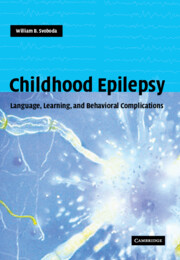Book contents
- Frontmatter
- Contents
- Preface
- Glossary
- 1 Looking ahead
- Part I Speech and language problems
- Part II Learning problems
- Part III Behavior problems
- 27 Mental health needs
- 28 Psychologic development
- 29 Seizure types and modifying factors
- 30 Overview: extrinsic factors
- 31 Behavior problems: general
- 32 Attention deficit disorders
- 33 Anxiety disorders
- 34 Mood disorders
- 35 Disruptive behavior problems
- 36 Psychoses of epilepsy
- 37 Non-epileptic events
- 38 Possible treatment issues
- 39 Helping with psychiatric problems
- 40 Epilog
- Index
- References
31 - Behavior problems: general
from Part III - Behavior problems
Published online by Cambridge University Press: 26 October 2009
- Frontmatter
- Contents
- Preface
- Glossary
- 1 Looking ahead
- Part I Speech and language problems
- Part II Learning problems
- Part III Behavior problems
- 27 Mental health needs
- 28 Psychologic development
- 29 Seizure types and modifying factors
- 30 Overview: extrinsic factors
- 31 Behavior problems: general
- 32 Attention deficit disorders
- 33 Anxiety disorders
- 34 Mood disorders
- 35 Disruptive behavior problems
- 36 Psychoses of epilepsy
- 37 Non-epileptic events
- 38 Possible treatment issues
- 39 Helping with psychiatric problems
- 40 Epilog
- Index
- References
Summary
William Lennox advised us: “The burden of proof sits on anyone who contends that psychic symptoms in the absence of other epileptic symptoms is epilepsy.”
Psychiatric challenges in seizure patients include personality disturbances, anger and aggressive reactions, depressions and suicidal reactions, hysterical behaviors, and psychotic disturbances. Children may have problems of immaturity, hyperactivity, temper, or acting-out episodes (Svoboda, 1979). In children, the emotional status may or may not relate to the age of seizure onset, the duration, the attack frequency, the EEG abnormality, or the extent of neuropsychological impairment (Berg et al., 1984). Family functioning variables are more influential in children with epilepsy (Hinton & Knights, 1969; Rutter et al., 1970; Whitehouse, 1971; Holdsworth & Whitmore, 1974; Cavazzuti, 1980; Weisbrot & Ettinger, 2001). The incidence of psychiatric disturbances at the time of seizure onset is between 24% and 45% (Papero et al., 1992; Austin et al., 1993; Dunn et al., 1997).
Children with epilepsy experience psychiatric disturbances four to five times more often than do children in control groups (Rutter et al., 1970; Henricksen, 1977). Comparing other medical conditions in childhood, the incidence of psychiatric problem is 31–48% in children with epilepsy, 21% in children with cardiac problems, 17% in children with diabetes, and 8.5% in controls (McDermott et al., 1995; Austin, 2001). If children are retarded and have epilepsy, the incidence of behavior problems is about 59% (Steffenburg et al., 1996).
- Type
- Chapter
- Information
- Childhood EpilepsyLanguage, Learning and Behavioural Complications, pp. 459 - 476Publisher: Cambridge University PressPrint publication year: 2004



